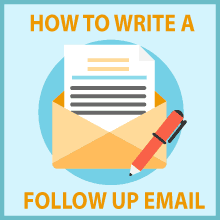
I can’t recall the first time I saw a firm ‘no’ in my inbox, but I sure do remember the last. Why? It happened just a few days ago. There was also a twist. That rejection wasn’t what I thought it was. By the end of the email thread, I was reminded, once again, how important it is to learn how to write a proper follow-up email.
But let’s get back to the email that got this train of thought started.
The last rejection I received was brutal. The response to my well-researched, personalized message consisted of a single word:
‘Unsubscribe’.
Look, I knew my email was good — or at least it wasn’t awful. But the harshness of the reply still got the best of me.
I felt shame sending shivers down my spine. In my mind, the picture was clear. The guy who opened my message thought that it sounded as robotic as a mass email campaign.
It didn’t help that at the time I was testing a tool called Crystal for our article on salespeople Chrome extensions. Crystal analyzes your prospect to summarize their personality. It told me that my recipient was ‘extremely direct’.
Meaning that a one-word rejection totally made sense.
I felt like an amateur.
But then I decided to follow up.
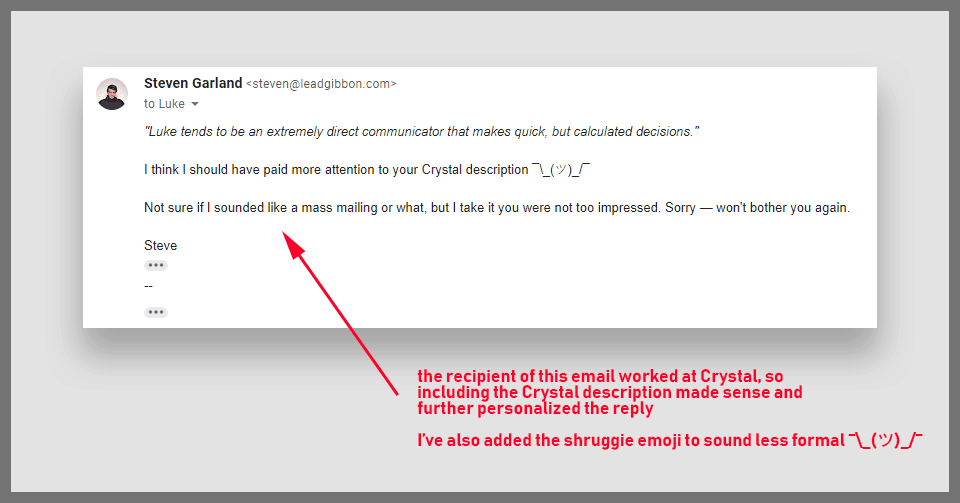
The response came in immediately. It wasn’t the one I expected at all:
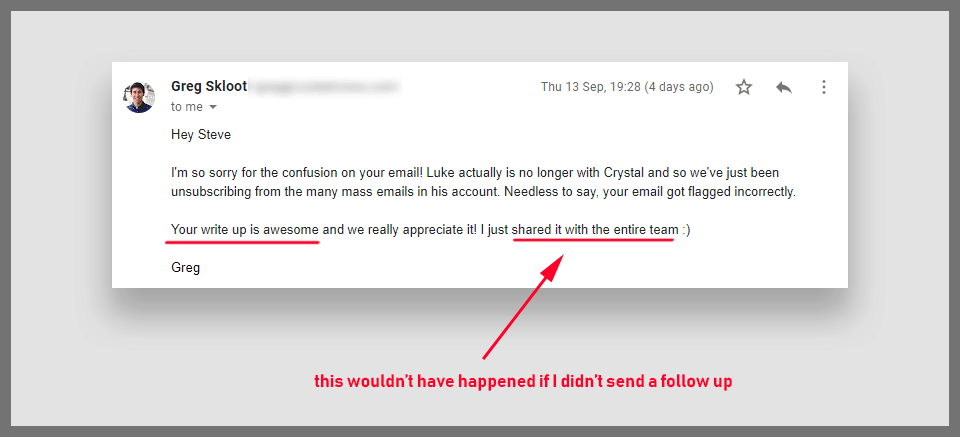
And this is why it’s so important to learn how to write a good follow-up email after you got rejected. Way too often, you’re not as rejected as you think you are.
But you wouldn’t know without a follow-up.
Follow up, follow up, follow up
We already covered the ground of why it’s important to follow up in our guide to follow-up email samples, so I’ll keep this one short.
Here’s some data on why multiple follow-ups are essential for sales success:

(Source: Marketing Donut)
Most prospects need to see several follow-ups before making a decision. But close to a half of sales reps give up at the first rejection — and most of them give up before the fourth.
Which means that if you’re following up diligently, you have a clear shot at winning all those leads your competition ignored.
But hey, you might ask, isn’t it important to respect a prospect’s rejection of your offer?
Well, what if I say that most rejections are often not rejections at all?
All the reasons why you get rejected (and how to take advantage of them)
Cold emails are annoying. By their nature, an incoming cold email is another task on your prospect’s already way too long to-do list. A task that nobody asked for.
If you’re sending cold emails, you probably already knew this. And that’s why it’s easy to jump to conclusions at the first sight of rejection.
These conclusions often sound like this:
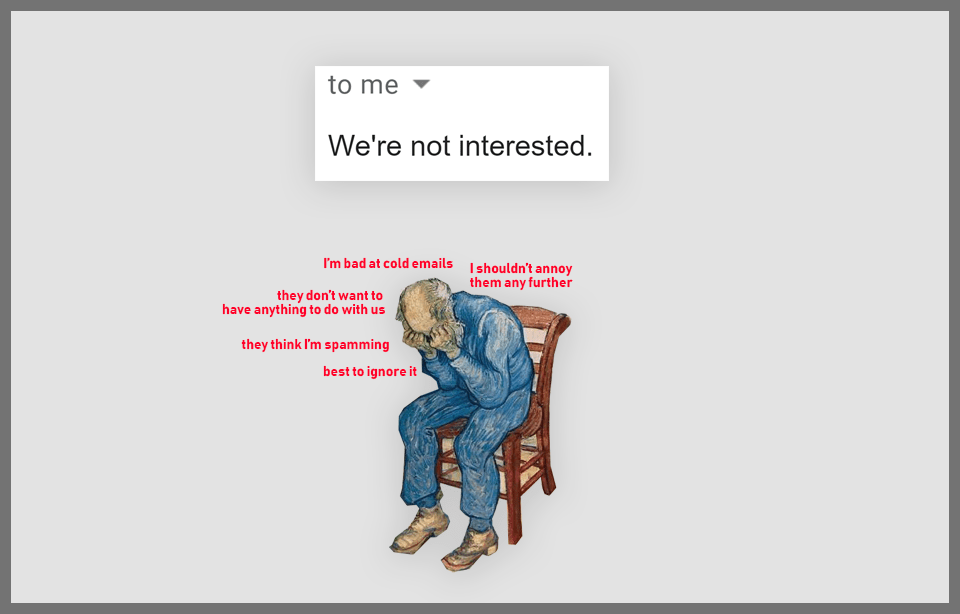
But in my experience, the reason you think you got rejected, and the actual reason for the rejection are often completely different.
And the best news?
In most rejections, prospects actually tell you how they want to be approached:
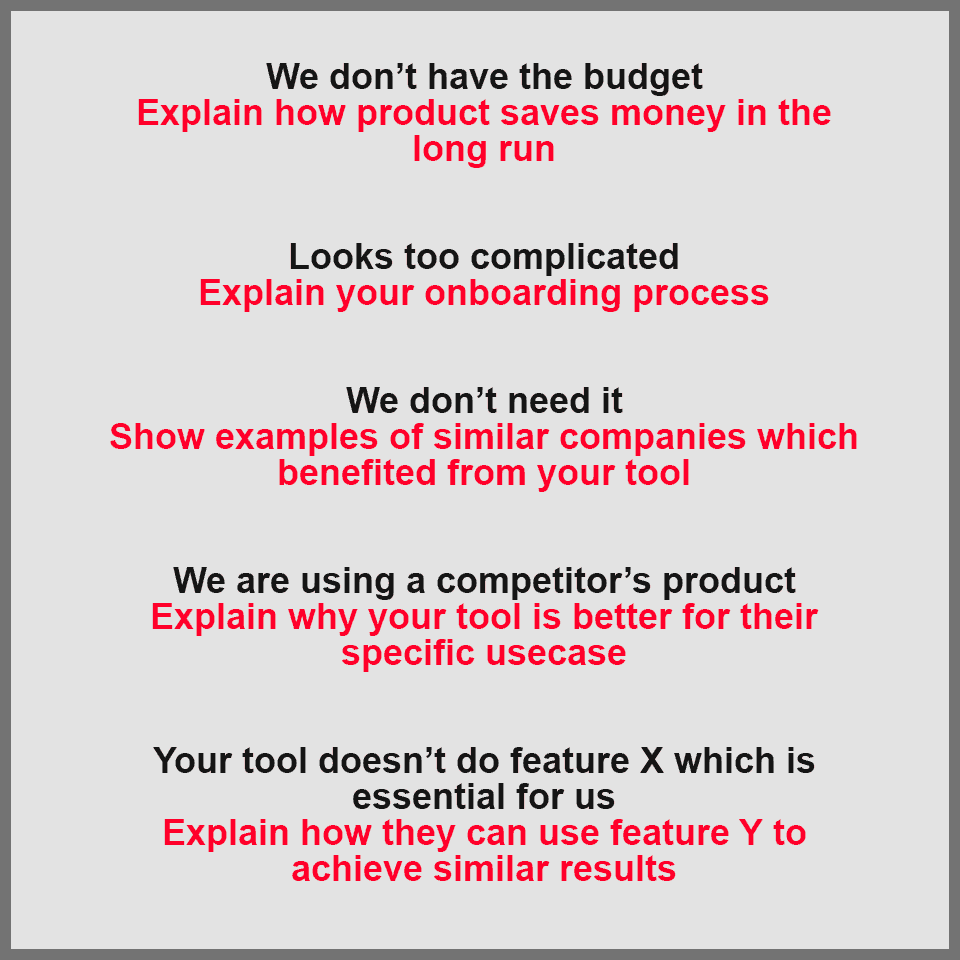
How to write a good follow up email that will turn rejection to your advantage
Yes, some rejections will be firm NO’s. Others will be downright nasty. In some cases, there won’t be much room to close a deal.
But even a firm ‘NO’ can still be useful to you — if you understand the true reason behind it.
Perhaps the problem is with your sales pitch, which doesn’t highlight your unique selling point. Or with the way you’re writing cold emails. Maybe you were not able to establish enough trust in your relationship.
Or maybe you just didn’t allocate enough time for prospecting and chose non-ideal targets for cold emails (in that case read our article on prospecting to find out what you might be doing wrong.)
So what should you do if you receive more rejections than you’re comfortable with? Stop your outreach activities and take a hard look at the way your sales strategy is working. More often than not, you’ll find something to improve.
After much suffering, I learned to love the rejections I receive. They make it easier to understand what I’m doing wrong — and fix it.
Tip #1 — Find out what the rejection is about

This is a default follow up if you receive a rejection that doesn’t say why your offer isn’t going to work out.
More often than not, the reason for a short rejection message isn’t that your prospect doesn’t like you. They just don’t see a reason to elaborate. Politely ask them for feedback and they would be happy to provide it.
The ‘polite’ part is key, by the way. A short rejection email can be annoying, but a passive-aggressive ‘Shame, care to explain why?’ will get you a grand total of 0 useful feedback received.
On the other hand, a polite follow-up focused on feedback not only keeps the conversation going, but also gives you access to other strategies we discuss in this article.
Tip #2 — Reframe your pitch

Most sales pitches highlight a single best feature of a product. But you might encounter situations when focusing on a unique selling point isn’t enough to convert a particular prospect.
What some potential customers are looking for is a combination of features. Or a smaller feature that will distinguish your product from the competition. Or integrations with other instruments in their toolset. Maybe they value long-term support, and you just didn’t mention it.
Which is to say, it’s hard to nail the perfect pitch on the first try. That doesn’t mean that you don’t get a second shot.
Consider rejections like the one above an opportunity to present your product from a different angle. Put as much time as possible into researching your prospect. Pay attention to the tools they already use and the way in which those tools present themselves.
Use new information to craft a pitch that shows how your product is going to improve the work of your prospect.
Tip #3 — Challenge their perception

Do you believe in the product that you’re selling? If you do, that’s great — then it’ll be easy to come up with the right rebuttal to any reason for rejection.
If a prospect thinks your product is too complicated, assure them that your onboarding process is newbie-friendly. If your product is ‘too limited’, explain why the team decided to focus on a specific approach, and why it’s working. In any case, supplement it with research and relevant content.
Prospects will often decline your offer, while actually being on the fence about your product. Consider these rejections not to be rejections at all. They are points to challenge your potential buyers on, and opportunities to communicate value.
If you ignore these (or send a follow-up closing the conversation), you risk losing a lead whom you had every chance of converting. The main thing about this approach is to know your product inside and out. The most well-researched rebuttals will be the most thought-provoking.
Tip #4 — Make an offer
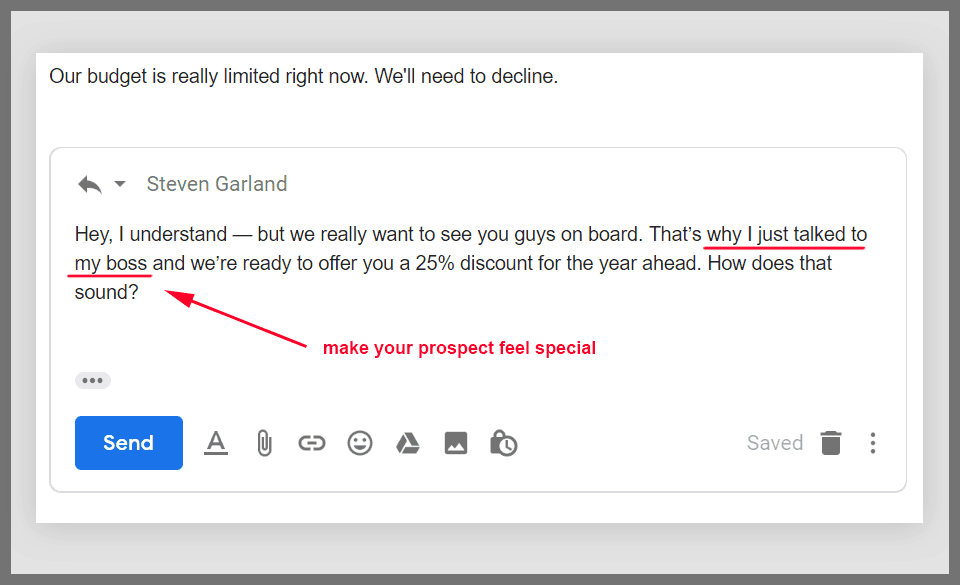
Who doesn’t love a discount? A strategically applied offer can instantly turn the tide in your favor.
Tips for using this approach should be pretty obvious. Don’t offer discounts to everyone, and don’t offer such a huge discount that you’ll lose on the deal. Try to analyze what kind of an offer the target company will say ‘yes’ to before making it (perhaps by understanding the cost of tools they are using right now.)
In addition to discounts, you can experiment with offering extended trials, a premium account for the same price, etc.
Tip #5 — Let’s stay in touch
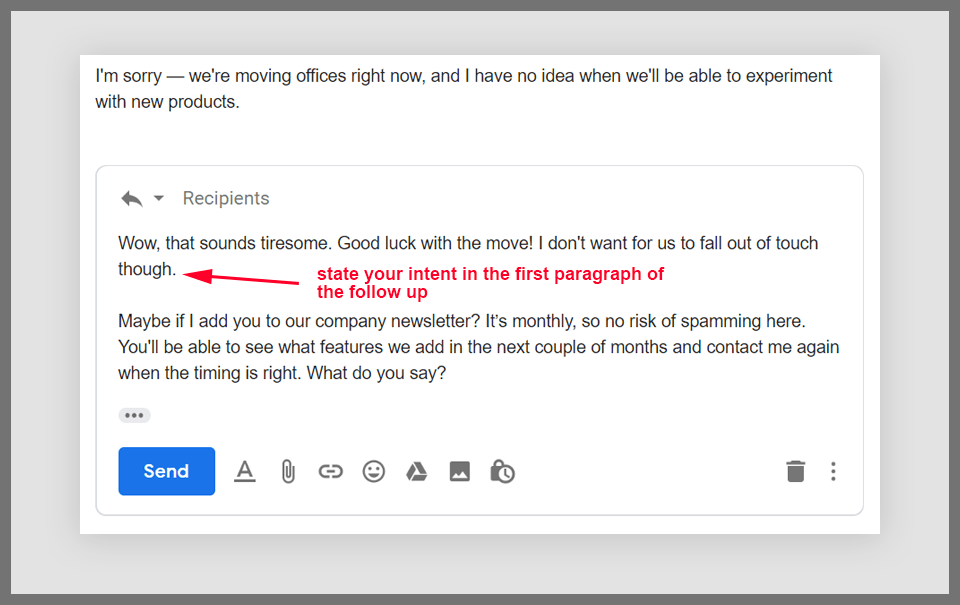
Sometimes your timing is going to be plain wrong. Even if your prospect seems interested, maybe they just don’t have the resources to close a deal right now.
In that case, your best bet would be to ask your recipient to stay in touch until their circumstances are resolved.
Obviously, don’t proceed to spam them with a daily newsletter after that. But a monthly automated follow up with some news about your company will work just fine.
This way you’ll be keeping the lead warm until better times. And when the timing is right, they’ll be up-to-date on your product’s development. Label them as ‘contact later’, and follow up on your deal properly in a couple of months.
Tip #6 — Ask for ways to improve
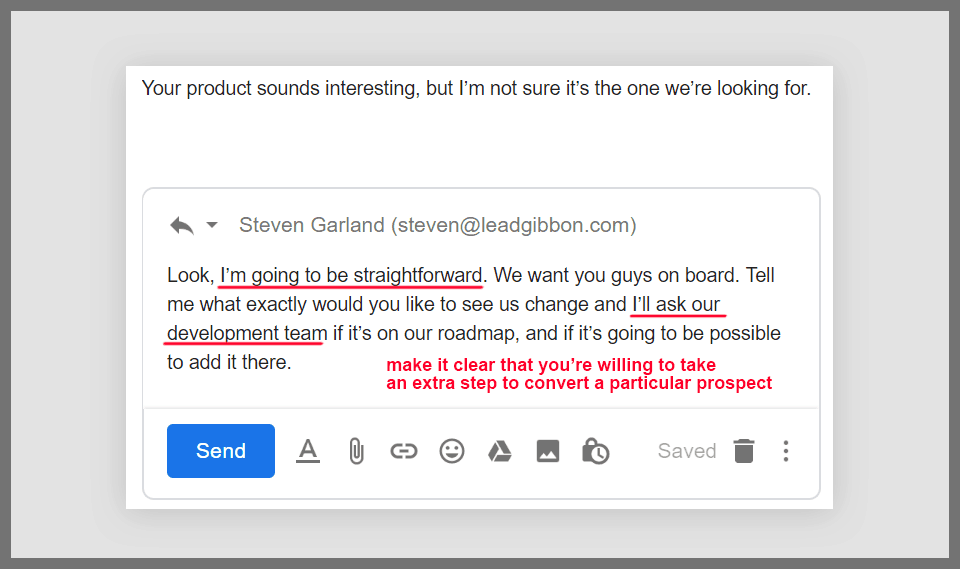
If you really want a prospect to close a deal, make it explicit that you’re ready to add something just for them.
Outright ask them what they would like to see in your product. Then discuss with your team how possible it would be to implement it.
Even if your team isn’t ready to put a new request on the roadmap, this follow-up template has a lot of value. It shows your potential customer how much you care about the deal — and sometimes it’s just enough to persuade them to switch.
Tip #7 — Close the conversation
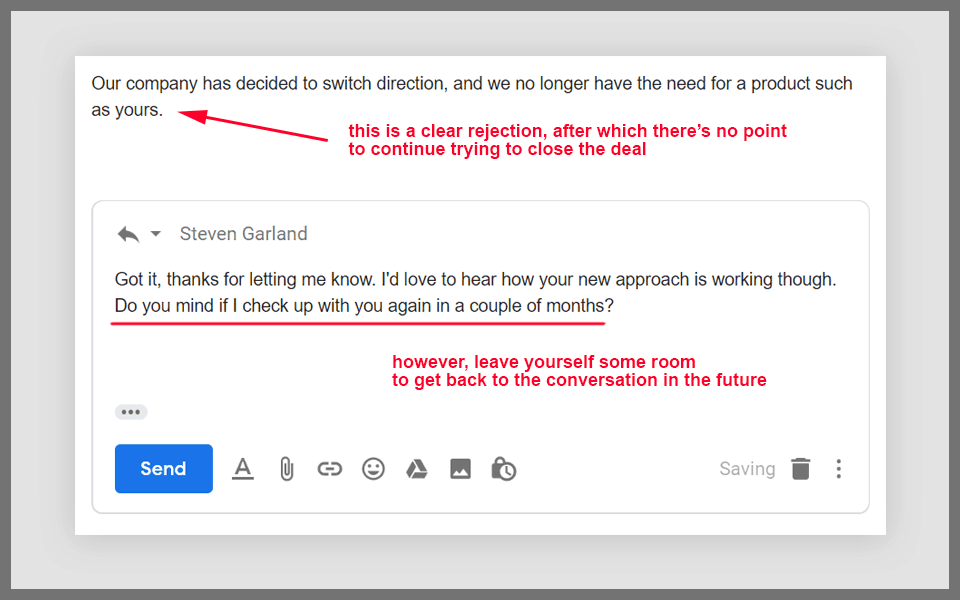
Yep, sometimes a rejection is just a rejection. Companies switch direction or sign up with your competition. When that happens, you have no immediate route to turn a rejection into a win.
Does that mean abandoning the conversation? Of course not. A follow-up like the one above highlights that you are interested in the prospect and that you’ll be able to continue the conversation when needed. Leave that email thread on a positive note!
Reply to nasty rejections like a pro
So far the rejections we mentioned in this article were polite and professional. As a sales rep, you had a clear route to winning your prospects over.
In real life, things just aren’t so smooth.
That’s why you need to learn how to deal with rejections that sound like this:
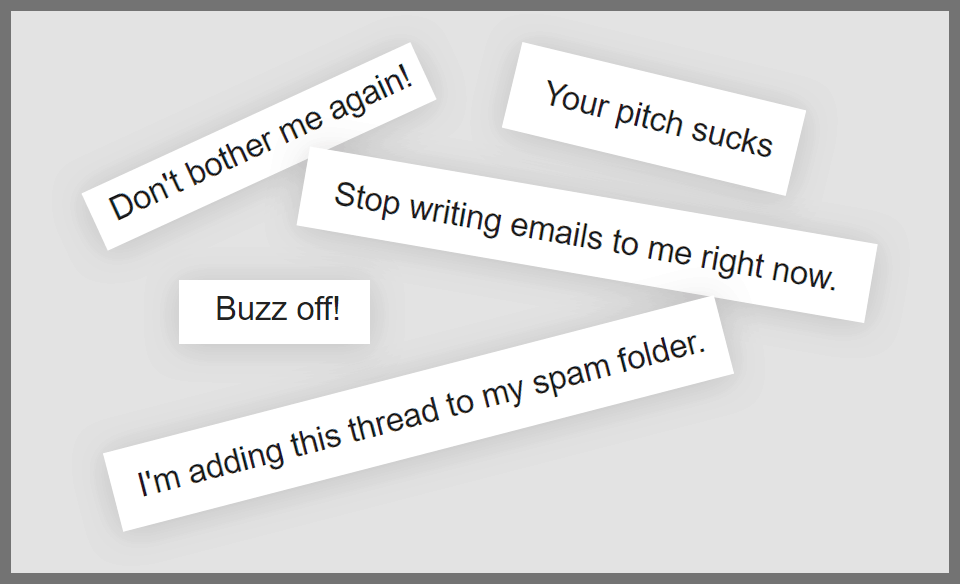
What’s the reason for writing a follow up for nasty rejections? Often people don’t really think about a human being on the other end of the line. After a hard day at work, they just want to lose some steam.
And your pitch got in the way.
The most important thing is not to be bitter. Don’t reply with a ‘no, screw you!’ if you received a nasty rejection. Instead, politely state that you tried your best and apologize for wasting their time.
After all, there’s always a chance that you emailed somebody who’s no longer at the company and their teammates are unsubscribing the old account from incoming communications 🙂
However, if you receive more than one nasty rejection in a short period of time, consider it a red flag for your cold email strategy. Re-evaluate your ideal customer profile, the strength of your pitch and how much time you’re investing into relationship-building. This will help you minimize the number of bad rejections in the future.
Conclusions
Rejections happen. Don’t be afraid of them!
Approach rejection as an opportunity to win a potential customer or improve your strategy. A simple follow-up will be enough to achieve both. You’ll learn to love rejection in no time — often they are more helpful than harmful.
So, when was the last time you received a rejection email? How did you approach your response? If you have some turn around stories, don’t hesitate to share them in the comments section below!

Great article.
If I’ve onboarded a new customer but months down the line buyer has not made an initial order with us how could I best approach the customer with an email?
Thanks, Courtney! It’s a good question, isn’t it? Practically warrants writing another blog post 🙂 It really depends on your product. For example, if the user has exhausted their free trial but didn’t convert, I’d send him an email explaining all of the new features you added with a link to extend their trial for free.